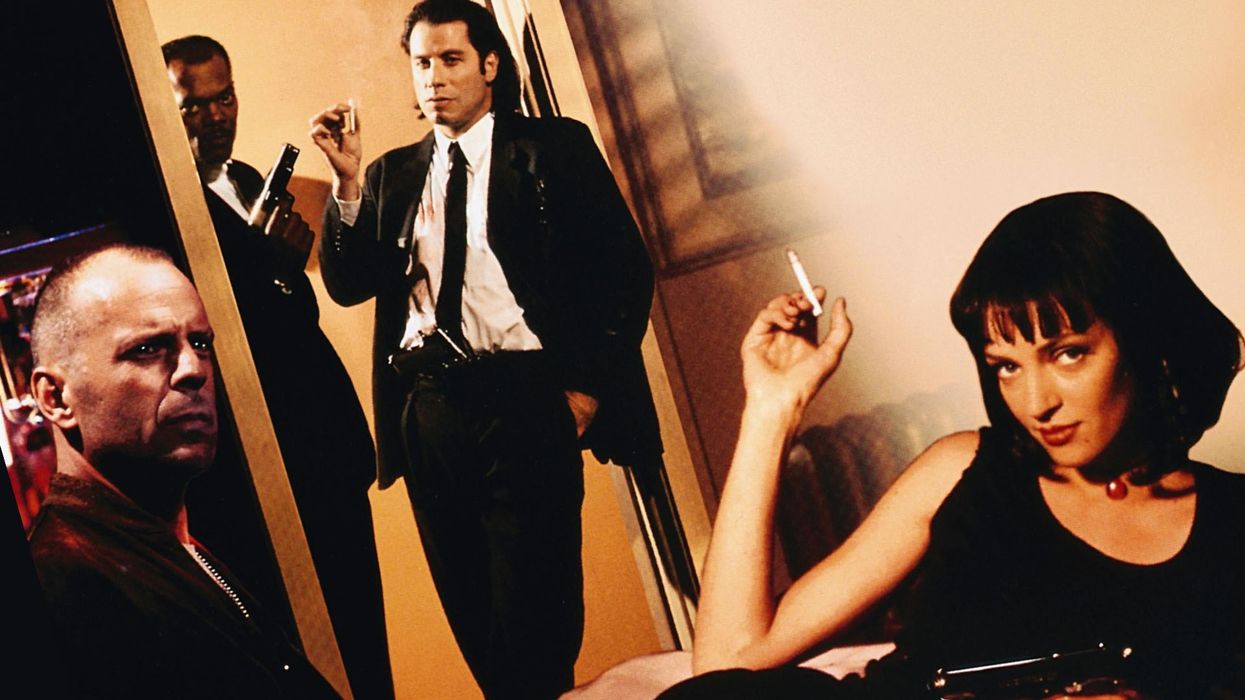Watch: If You Turn the Sound Off, 'Pulp Fiction' is Still Brilliant. Here's Why
This video removes all the dialogue from Pulp Fiction to see how the movie functions as pure visual storytelling.

If there's one thing Quentin Tarantino is known for, it's the dialogue in his films. But what if there were no dialogue? Would his movies still hold up?
By removing the dialogue from Pulp Fiction, this video essay from Cinema Break seeks to answer that question. The result may surprise you.
One of the most eminently quotable films in recent memory, Pulp Fiction'sdialogue has entered the pop culture vernacular in a way that few other films have. It's practically taken for granted that Tarantino relies on dialogue to tell his stories. To be sure, it's an important part of his films, but this video shows how the director's visual storytelling is just as important as the rapid-fire dialogue that earned Pulp Fiction an Oscar for Original Screenplay.
Several scenes have had their dialogue stripped, leaving only the ambient sound and Tarantino's (and the late Sally Menke, his long-time editor) cuts to tell the story. The results show how much of Pulp Fiction follows legendary editor Walter Murch's oft-cited "Rule of Six," his list of principles that make for good visual storytelling.
According to Murch, an ideal cut is one that follows the following principles:
1. Is true to the emotion of the moment
In the moments before Vincent injects Mia with the adrenaline shot that will save her life, Tarantino goes from an extreme closeup, push in, and rack focus on the needle (in a sense, "cutting" within the shot by changing our focus) to a cut to Mia's seemingly lifeless face. This is then accompanied by another dolly toward her face, to shots of Lance the dealer. All of these shots are timed to the 1-2-3 rhythm heard on the soundtrack (though, of course, not in this silent recut). It ratchets up the tension to the point of being almost unbearable to watch, knowing what's at stake for Vincent and especially for Mia.
2. Advances the film's story
When Butch wakes from his dream of Christopher Walken telling him the story of the provenance of his father's watch, Tarantino employs a cut that is usually a trope. Not so here. This is because the action that precedes it—Walken's hilarious monologue—is so out of context and strange that the cut to Butch waking from the dream advances the story in a few ways. Firstly, it throws us into a state of confusion, just like Butch before the fight. Secondly, it establishes the importance of the watch to him. And lastly, it moves us from the dream into a new segment of the film—away from Vincent's narrative and into Butch's story.
3. Occurs at a moment that is rhythmically interesting and "right"
This is apparent in one of the first shots in the video, when Jules and Vincent walk into the apartment where the briefcase is hidden. Notice the rapid cutting on the lock, followed by Jules and Vincent's entrance into the apartment occupied by the nervous thieves.
4. Acknowledges the audience's "concern with the location and movement of the audience’s focus of interest within the frame"
When Butch escapes from the clutches of Zed, but returns to save Marcellus out of a crisis of conscience, Tarantino blocks the scene of his revenge perfectly, using both cuts and movement within the frame (e.g., Butch stepping to the left in the frame and revealing Marcellus) to orient the viewer within the basement space as well as to direct the audience's attention inside the frame.

5. Respects "planarity"—the grammar of three dimensions transposed by photography to two (questions of stage-line, etc.)
When The Wolf arrives at Bonnie's house, his car speeds up the street at a ludicrous speed, approaching from a long shot and ending in a close-up of the car's license plate, the shot employs the "planarity" of the frame as the car advances towards us in an echo—perhaps unintentional, though with Tarantino you never know—of L'arrivée d'un train en gare de La Ciotat, the 1895 Lumière Brothers' film that supposedly frightened audiences, who thought the train was going to hit them. Here, as in all the other cited cuts and visuals, it isn't done just because it's "looks cool"(the sin of so many Tarantino imitators); rather, the entire sequence introducing his character telegraphs a speed and efficiency that will be a hallmark of his character's actions.
6. Respects the three-dimensional continuity of the actual space (where people are in the room, in relation to one another)
At the end of the film, when Jules, newly converted by the "miracle" that saved his life, gives his speech and lets Ringo leave unharmed, the scene is shot and cut mostly in closeups and over-the-shoulder shots that hold the tension of the moment. This is because we can see Jules pointing the gun and then, in reverse, pointing it away, signifying Ringo's release and his newfound pacifism. Then, cutting back wider, but still in an O.T.S. shot, we see Ringo leave as Jules eats, watching; the cut to Ringo leaving with his girlfriend Honey Bunny takes place a few seconds later, but the audience is at no time confused as to the characters' spatial relations to each other.
Whether in Pulp Fiction or any other film, it is absolutely critical to maintain an understanding of the grammar of cinema. This is something Tarantino absorbed through years and years of watching everything he could see. And while many directors break the rules and do so successfully (Godard's jump cuts are an easy example), it is impossible to break them without a firm understanding of what those rules are. Watching Pulp Fiction without the sound shows us these visual storytelling rules laid bare.
Source: Cinema Break











